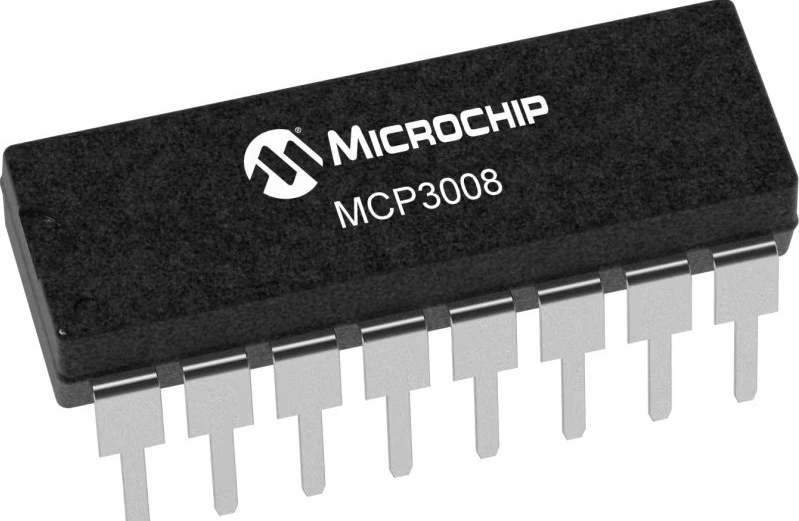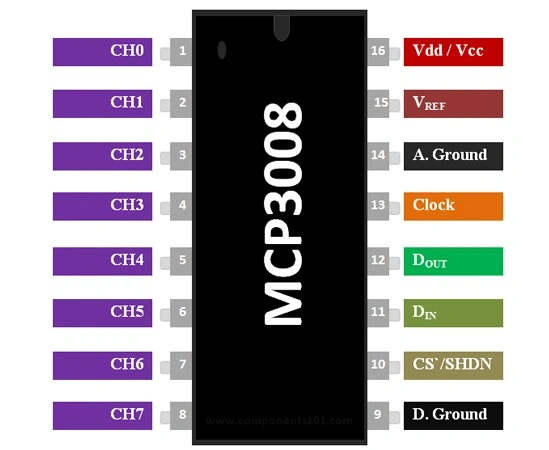OUTLINE:
Demystifying the MCP3008: Uncovering Price and Analog Channels
 152
152In this insightful guide, we peel back the layers surrounding MCP3008 analog-to-digital converters (ADCs), shedding light on pricing considerations and revealing reputable manufacturers.
Whether you're a seasoned electronics enthusiast or a newcomer to the world of ADCs, join us as we navigate the intricacies of MCP3008 procurement, equipping you with the knowledge needed to make informed decisions and unlock the full potential of this versatile component.

Image Source: Microchip Technology
What Is the MCP3008
The MCP3008 is a popular analog-to-digital converter (ADC) integrated circuit developed by Microchip Technology. It serves as a bridge between analog sensors and digital microcontrollers, allowing the conversion of analog signals into digital data for processing by digital systems.
The MCP3008 offers eight channels of 10-bit resolution, enabling the measurement of analog signals from multiple sources with high accuracy and precision.
Widely used in various applications such as sensor interfacing, data acquisition, and instrumentation, the MCP3008 is valued for its reliability, performance, and ease of use in converting analog signals into digital format for further processing or analysis.
What Are the Specs of the MCP3008
Analog Channels: The MCP3008 features eight analog input channels, allowing the simultaneous conversion of multiple analog signals into digital data.
Resolution: It provides a resolution of 10 bits, allowing for the conversion of analog signals into digital values ranging from 0 to 1023.
Sampling Rate: The MCP3008 supports a maximum sampling rate of 200 kilosamples per second (ksps), enabling fast and accurate conversion of analog signals.
Supply Voltage Range: It operates within a wide supply voltage range typically from 2.7V to 5.5V, making it suitable for various power supply configurations.
SPI Interface: The MCP3008 communicates with digital microcontrollers via the Serial Peripheral Interface (SPI) protocol, enabling straightforward integration with a wide range of microcontroller platforms.
Low Power Consumption: It features low power consumption, making it suitable for battery-powered applications and energy-efficient designs.
Temperature Range: The MCP3008 operates reliably within a wide temperature range, typically from -40°C to +85°C, ensuring performance in harsh environmental conditions.
Package Type: It is available in a compact 16-pin Dual In-Line Package (DIP) or Surface Mount Device (SMD) package, providing flexibility for different board designs and assembly processes.
What Is the Function of MCP3008
The MCP3008 serves as an analog-to-digital converter (ADC), translating analog signals from sensors or other sources into digital data that can be processed by a microcontroller or digital system.
Its primary function is to convert continuous analog signals into discrete digital values, enabling measurement, analysis, and processing in digital circuits.
Here's a breakdown of its key functions:
Analog Signal Conversion: The MCP3008 accepts analog input signals from sensors, transducers, or other analog sources connected to its input channels.
It converts these analog signals into digital values, providing a numerical representation of the input signal's magnitude.
Resolution: With a resolution of 10 bits, the MCP3008 can represent analog signals with high accuracy, providing 1024 discrete digital values over the input voltage range.
Multiple Input Channels: It features eight analog input channels, allowing for the simultaneous conversion of multiple analog signals.
This capability is useful for applications requiring the measurement of multiple sensors or signals.
SPI Communication: The MCP3008 communicates with microcontrollers or digital systems using the Serial Peripheral Interface (SPI) protocol.
This enables straightforward integration with a wide range of microcontroller platforms, facilitating data transfer and control.
Sampling Rate: With a maximum sampling rate of 200 kilosamples per second (ksps), the MCP3008 can quickly and accurately capture analog signals, making it suitable for real-time monitoring and data acquisition applications.
Low Power Consumption: It features low power consumption, making it suitable for battery-powered applications and energy-efficient designs.
What Is the Price of MCP3008-I/SL Module
Here comes a format:
|
Platform |
Price |
Quantity Available |
Advantage |
Review |
|---|---|---|---|---|
|
Chipsmall |
1+ US $2.4540 10+ US $2.2086 30+ US $1.7178 |
41380 |
High Accuracy and Resolution |
4.6 |
|
Digikey |
1+ US$2.9 25+ US$2.41 100+ US$2.2 |
2,055 |
Versatility in Application |
4.4 |
|
Mouser |
1+ US$2.71 25+ US$2.35 100+ US$2.17 |
16,556 |
Cost-Effectiveness |
4.6 |
What Are the Analog Channels of MCP3008
The MCP3008 analog-to-digital converter (ADC) is equipped with a total of eight analog input channels, denoted as CH0 through CH7.
These channels serve as entry points for analog signals into the MCP3008 device, enabling the conversion of analog voltage levels into digital representations.
Each analog input channel corresponds to a specific pin on the MCP3008 chip, allowing users to connect external analog sensors, transducers, or other analog devices directly to the ADC.
Here is a detailed breakdown of the analog channels for the MCP3008:
CH0: This is the first analog input channel on the MCP3008. It corresponds to Pin 1 (CH0) on the device and serves as the primary input channel for analog signals.
CH1: The second analog input channel on the MCP3008, corresponding to Pin 2 (CH1) on the device. It provides an additional input channel for sampling analog signals.
CH2: The third analog input channel, mapped to Pin 3 (CH2) on the MCP3008. It offers another channel for connecting analog input sources.
CH3: This is the fourth analog input channel, associated with Pin 4 (CH3) on the MCP3008. It expands the number of available channels for analog signal conversion.
CH4: The fifth analog input channel, designated by Pin 5 (CH4) on the MCP3008. It provides yet another channel for sampling analog signals.
CH5: The sixth analog input channel, corresponding to Pin 6 (CH5) on the MCP3008. It adds another input channel to the ADC for analog signal processing.
CH6: This is the seventh analog input channel, mapped to Pin 7 (CH6) on the MCP3008. It further extends the capability of the ADC to accommodate additional analog input sources.
CH7: The eighth and final analog input channel on the MCP3008, denoted by Pin 8 (CH7) on the device. It completes the set of analog input channels available for analog-to-digital conversion.

Image Source: Components101
Final Verdict
"Demystifying the MCP3008" serves as a beacon of clarity amidst the complexity of analog-to-digital conversion, guiding readers toward mastery of the MCP3008 and unlocking its full potential in a myriad of applications.
With newfound understanding and confidence, readers are poised to embark on their journey of innovation and exploration in the realm of analog electronics.

Disclaimer: The views and opinions expressed by individual authors or forum participants on this website do not represent the views and opinions of Chipsmall, nor do they represent Chipsmall's official policy.

share this blog to:

